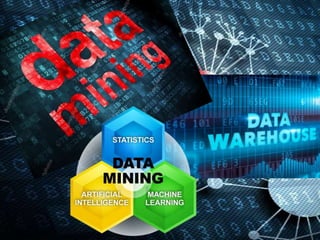Data Mining and Data Warehouse
- 2. ï INTRODUCTION ï DATA MINING ï WHY DATA MINING ï APPLICATION OF DATA MINING ï STEPS OF DATA MINING ï DATA MINING TECHNIQUES ï THREAT OF DATA MINING ï SOLUTION OF THREAT ï ROLE OF DATA MINING ï DATA WAREHOUSE ï OLTP & OLAP ï DATA MINING TOOLS ï LATEST RESEARCH
- 3. INTRODUCTION Data mining, the extraction of hidden predictive information from large databases, is a powerful new technology with great potential to help companies focus on the most important information in their data warehouses.
- 4. DATA MINING It is extraction of previously unknown, valid and understandable information or pattern from data in repositories or sources : ïķ Databases ïķ Text files ïķ Social networks ïķ Computer simulation The information obtained should be such that is can be used in any organizations and enterprises for business making.
- 5. Why Data Mining ? Data. Data everywhere yet ïķ I canât find the data I need ïķ I canât get the data I need ïķ I canât understand the data I found ïķ I canât use the data I found
- 6. âĒ Data explosion problem Advance data collection tools and database technology lead to tremendous amounts of data stored in database. âĒ We are drawing in data, but starving for knowledge! âĒ Solution: Data warehousing and Data mining - Data warehousing and on-line analytical processing. - Extraction of interesting knowledge using data mining.
- 7. APPLICATION OF DATA MINING Data Mining is primarily used today by companies with a strong consumer focus â retail, financial, communication, and marketing organizations.
- 8. 1. FINANCE INDUSTRY Credit Card Analysis
- 9. 2. INSURANCE INDUSTRY Claims and Fraud Analysis
- 10. 3. TELECOMMUNICATION Call Record Analysis
- 12. 5. CONSUMER GOODS Promotion Analysis
- 13. 6. SCIENTIFIC RESERCH Image, Video, Speech
- 14. 7. UTILITIES Power Usage Analysis
- 15. STEPS OF DATA MINING ï Data integration ï Data selection ï Data transformation ï Data mining ï Pattern evaluation ï Knowledge presentation
- 17. DATA MINING TECHNIQUES Classification and Prediction example â Focused Hiring Cluster Analysis example â Market Segmentation Outlier Analysis example â Fraud Detection Association Analysis example â Market Basket Analysis Evolution Analysis example â Forecasting stock market index using Time series Analysis
- 18. Threat To Privacy From Data Mining They data mine information about your buying habits, sites you surf, so they can personalize your search results when you use their search engine. It's both frightening but on the other hand, in theory it's a way for companies to tailor your online experience. The problem, of course, is that while generally the data isn't scoured by humans, it is used by machines.
- 19. SOLUTION OF DATA MINING THREAT SOLUTIONS : ï Purposes Specification & Use Limitation ï Openness ï Security Measures like Encryption
- 20. ROLE OF DATA MINING IN IT Business Intelligence Model Tool Method Behavioral Basics Information TechnologyData Problem Decision
- 21. DATA WAREHOUSE Data warehousing is a technology that aggregates structured data from one or more sources so that it can be compared and analyzed for greater business intelligence.
- 23. DATA WAREHOUSE ï Data warehouse provides the enterprise with a memory. ï Data Mining provides enterprise with intelligence.
- 24. OLTP & OLAP On-Line Transaction Processing (OLTP) Short, simple, frequent queries and modifications Each involving a small number of tuples Example â answering queries from a web interface, sales at cash registers, selling airline tickets. On-line Application Processing (OLAP) Few but complex queries --- may run for hours. Queries do not depend on having an absolutely up-to-date Database. Example â analyst at Wal-mart look for items with increasing sales in some region.
- 26. DATA MINING TOOLS ï Microsoft SQL Server 2005 ï Microsoft SQL Server 2008 ï Oracle Data Mining ï DB Miner
- 27. Latest Research and Reviews on Data Mining 1. Systematic discovery of mutation-specific synthetic lethal by mining pan- cancer human primary tumor data. 2. Multi-label Learning for Predicting the Activities of Antimicrobial Peptides. 3. Semantic correction system - Little complex but interesting. Generally retried text faces semantic error, hence leads to wrong result. Applying this as preprocessing leads to better outcomes.
- 28. 4. Syntactic correction system - Much needed now a days. Non-English speakers creates much syntactical error. It can also be used as preprocessing job in many projects. So you algorithm should automatically detect such errors and suggest correct grammar. 5. Search engine for Wikipedia - Wikipedia data available as dump file. Check dbpedia for reference. Apply indexing techniques and build small kind of SE for wiki pages. As Wikipedia already provides this functionality but you can work on better user experience, result optimization. 6. Twitter tweets classifier - Pretty easy and interesting too. Creating learning system for various categories kind of Sports, entertainment, business, politics, Hollywood etc. Train the classifier (naive bayes, SVM) and predict the category for incoming tweets.
- 29. 7. Sentiment analysis for twitter, review, conversations - There are few packages available in R which can help to perform this job. One needs to add few additional feature on top of that to make more intuitive. Nltk, Stanford, good open source tools for the same. 8. Spam mail detection - Again learning based classification system. Train the classifier using users pre-selected spam mail which would be able to classify new upcoming mails. If uses mark new mail as spam, then retrain(may be some other better option). 9. Sarcasms detection - This can be very interesting one. In sentiment analysis we identify users sentiment regarding something's, here we identify sarcasm expressed by users. Check out Page on psu.edu - Sarcasm detection on twitter





























